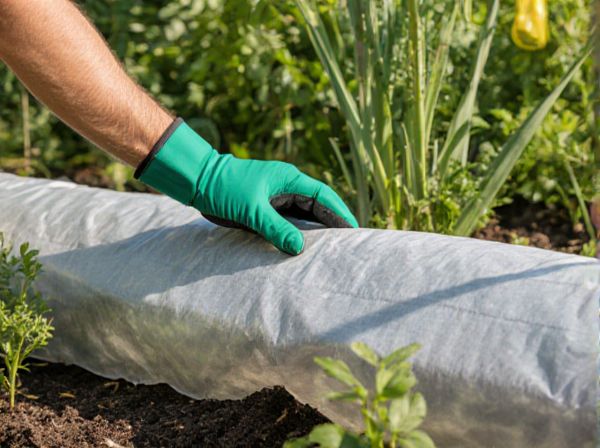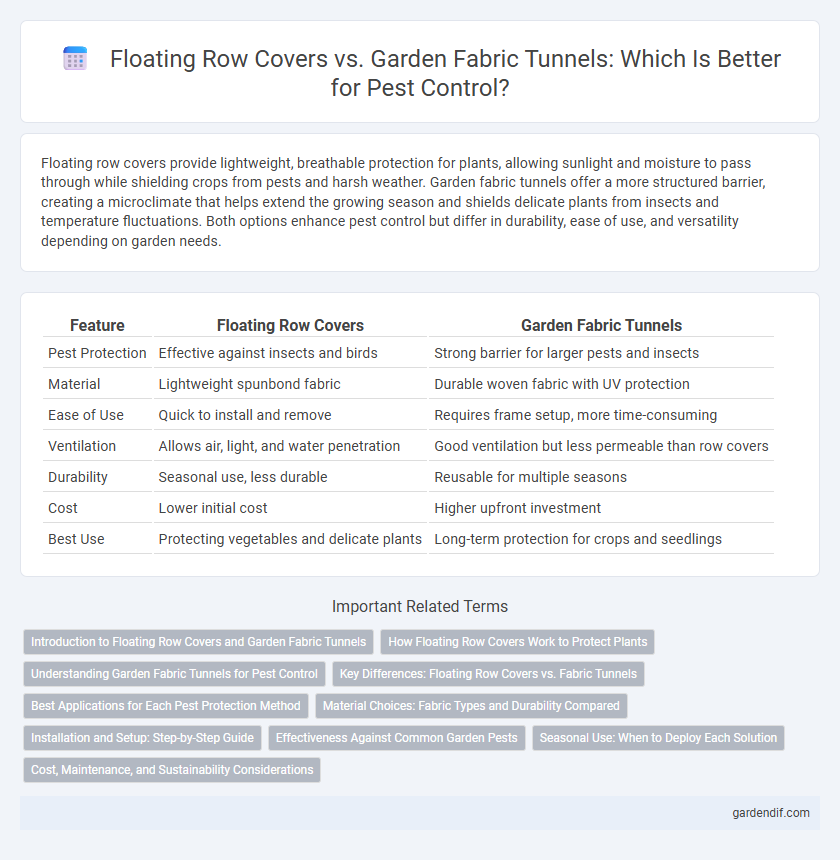
Floating row covers vs garden fabric tunnels Illustration
Floating row covers provide lightweight, breathable protection for plants, allowing sunlight and moisture to pass through while shielding crops from pests and harsh weather. Garden fabric tunnels offer a more structured barrier, creating a microclimate that helps extend the growing season and shields delicate plants from insects and temperature fluctuations. Both options enhance pest control but differ in durability, ease of use, and versatility depending on garden needs.
Table of Comparison
| Feature | Floating Row Covers | Garden Fabric Tunnels |
|---|---|---|
| Pest Protection | Effective against insects and birds | Strong barrier for larger pests and insects |
| Material | Lightweight spunbond fabric | Durable woven fabric with UV protection |
| Ease of Use | Quick to install and remove | Requires frame setup, more time-consuming |
| Ventilation | Allows air, light, and water penetration | Good ventilation but less permeable than row covers |
| Durability | Seasonal use, less durable | Reusable for multiple seasons |
| Cost | Lower initial cost | Higher upfront investment |
| Best Use | Protecting vegetables and delicate plants | Long-term protection for crops and seedlings |
Introduction to Floating Row Covers and Garden Fabric Tunnels
Floating row covers are lightweight fabrics placed directly over crops to provide protection from pests while allowing sunlight, air, and moisture to pass through, promoting healthy plant growth. Garden fabric tunnels are rigid or semi-rigid structures covered with protective fabric, creating a controlled microclimate that deters pests and shields plants from harsh weather conditions. Both methods serve as eco-friendly pest management solutions but differ in structure and suitability based on garden size and crop type.
How Floating Row Covers Work to Protect Plants
Floating row covers protect plants by creating a lightweight barrier that filters sunlight, water, and air while preventing pests such as aphids, beetles, and caterpillars from reaching the crops. These covers rest directly on plants, allowing them to grow beneath while maintaining a microclimate that reduces frost risk and supports healthy growth. Compared to garden fabric tunnels, floating row covers offer easier installation and flexibility for seasonal pest control in vegetable gardens.
Understanding Garden Fabric Tunnels for Pest Control
Garden fabric tunnels create a protective barrier around plants by enclosing rows in lightweight, breathable material that prevents pest access while maintaining airflow and moisture. These tunnels offer better pest control compared to floating row covers due to their more robust structure and ability to cover taller plants, effectively reducing infestation risks. Choosing fabric tunnels enhances pest management through physical exclusion, reducing the need for chemical treatments and promoting healthier plant growth.
Key Differences: Floating Row Covers vs. Fabric Tunnels
Floating row covers are lightweight, breathable fabrics primarily used to protect plants from insects and frost while allowing sunlight, air, and rain to penetrate. Garden fabric tunnels are more rigid structures that create a mini greenhouse effect, offering enhanced protection against pests, temperature fluctuations, and physical damage. Unlike floating row covers, fabric tunnels provide better support for taller plants and are easier to access for maintenance and harvesting.
Best Applications for Each Pest Protection Method
Floating row covers excel at protecting crops from flying insects like aphids, whiteflies, and cabbage worms by creating a breathable barrier that allows sunlight and moisture while preventing pest access. Garden fabric tunnels offer enhanced protection against larger pests such as rabbits, deer, and birds by providing a sturdier and more durable shield around plants, especially useful for berries and young shrubs. For optimal pest management, floating row covers suit smaller, volant insects in vegetable gardens, whereas fabric tunnels benefit perennial crops needing robust, long-term defense.
Material Choices: Fabric Types and Durability Compared
Floating row covers are typically made from lightweight spunbond polypropylene, offering excellent breathability and UV protection while allowing air, light, and moisture to penetrate, which supports healthy plant growth. Garden fabric tunnels often use heavier woven or non-woven materials, such as polyester blends or thicker polypropylene, providing enhanced durability and stronger protection against pests, wind, and extreme weather conditions. The choice between these materials affects longevity and pest control efficacy, with floating row covers favoring flexibility and garden tunnels emphasizing robust shielding.
Installation and Setup: Step-by-Step Guide
Floating row covers require anchoring edges with soil, staples, or weights to protect plants from pests while allowing light and moisture penetration. Garden fabric tunnels involve assembling lightweight hoops before draping fabric tightly over the frame, securing ends to prevent pest entry and maintain structure stability. Both methods enable easy access for watering and maintenance by lifting edges or removable sections without disturbing plant growth.
Effectiveness Against Common Garden Pests
Floating row covers provide a physical barrier that effectively blocks many common garden pests such as aphids, cabbage worms, and flea beetles by preventing direct contact with plants. Garden fabric tunnels also offer protection but may allow smaller pests to enter through seams or openings, reducing their overall effectiveness. For optimal pest control, floating row covers are generally preferred due to their tighter fit and complete enclosure around crops.
Seasonal Use: When to Deploy Each Solution
Floating row covers are ideal for early spring and fall to protect plants from frosts and cool-weather pests, extending the growing season effectively. Garden fabric tunnels provide a more rigid structure that shields crops from harsh summer pests and extreme weather, making them suitable for warmer months. Selecting the appropriate solution depends on the specific seasonal threats and crop requirements to optimize pest control and plant health.
Cost, Maintenance, and Sustainability Considerations
Floating row covers typically have lower upfront costs and are lightweight, making them easier to install and maintain compared to garden fabric tunnels, which often require more structural support. Maintenance for floating row covers involves occasional cleaning and storage at season's end, while garden fabric tunnels may need regular repairs due to their rigid frames and potential fabric wear. From a sustainability perspective, reusable floating row covers made from biodegradable or recyclable materials offer an eco-friendlier option, whereas garden fabric tunnels, often constructed with plastic components, may contribute more to environmental waste.
Floating row covers vs garden fabric tunnels Infographic

 gardendif.com
gardendif.com